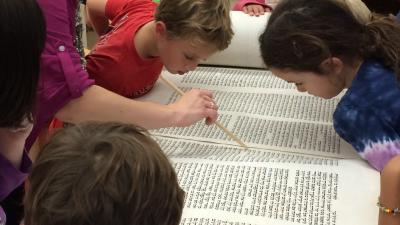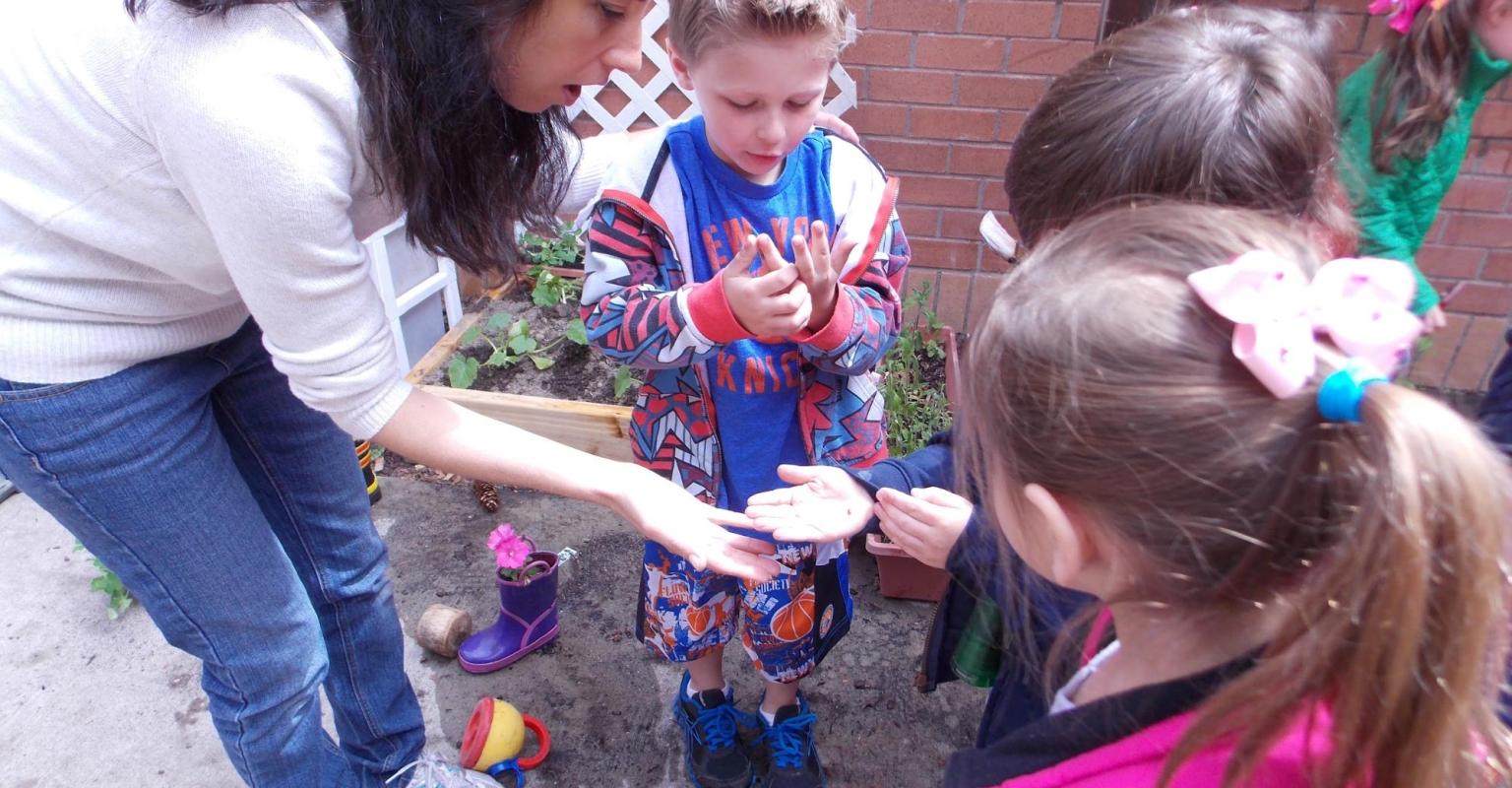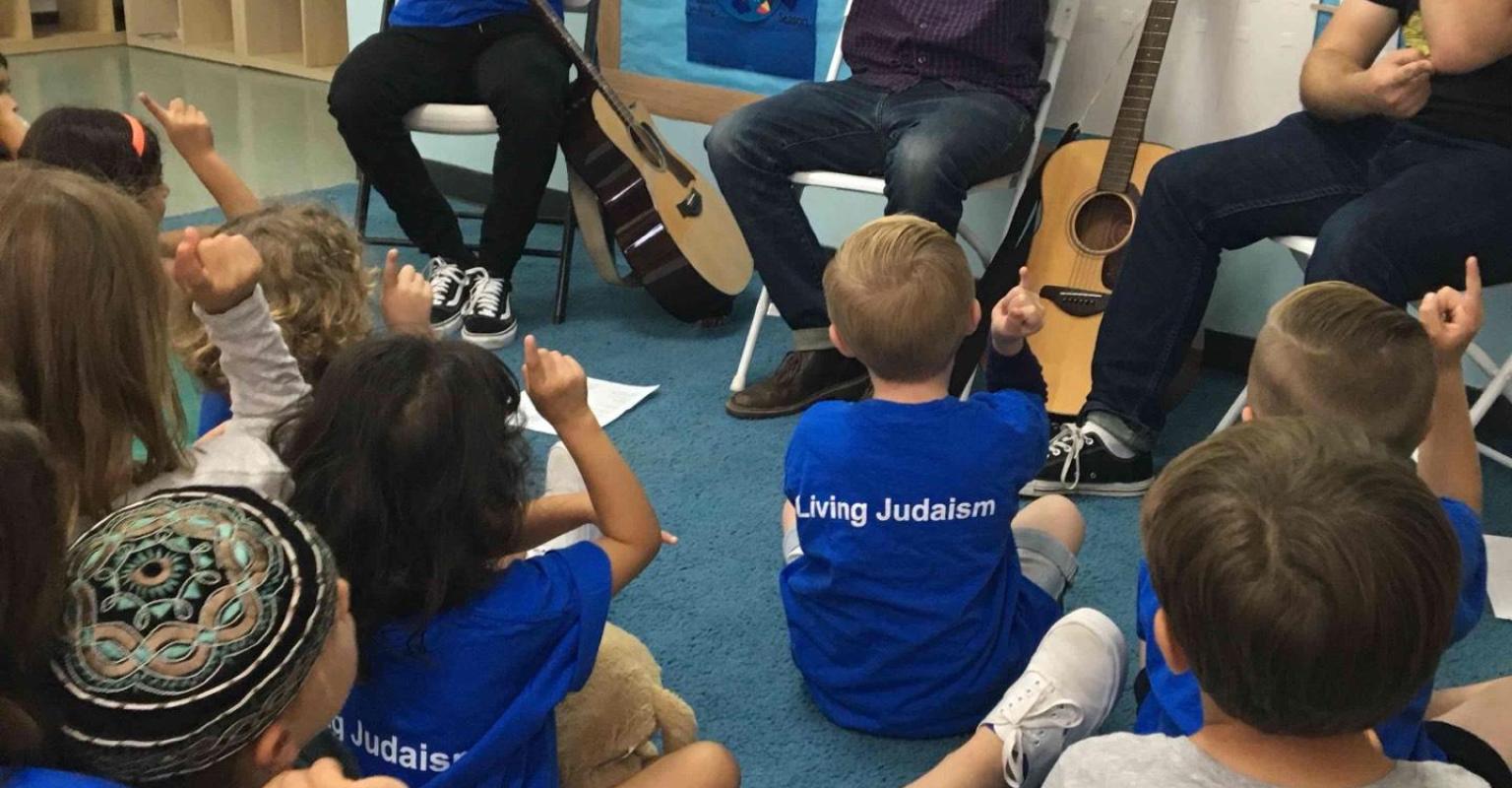Multi-aged, Project-Based, Experiential Learning: Mayim
Temple Beth Shalom, Needham, MA
Not all models fit neatly into one of our major groups (or “buckets”). As new innovations emerge and new experiments are designed, we envision more models may cross-over or be outside of these buckets. In the future, we will most likely identify new groupings based on the success of these models.
Mayim, our initial example, could be placed in a Multi-aged, Project-Based Learning, or Experiential Learning bucket.

Model Summary:
Mayim is a K-5 learning community in which depth of relationships and depth of learning are intentionally fostered and visible everywhere. Learning takes place in mixed-age groups (K‒1; 2‒3; 4‒5) of about 10 children in each group (a group is called a mifgash). These mixed-age groups are a key element of Mayim’s design and are a direct result of Temple Beth Shalom’s initial research regarding how and where children learn best. Based on the research which underscored the importance of a learner’s relationship with a caring adult, Mayim is designed so that each mixed age group (mifgash) learns with the same teacher (called a Jewish Learning Guide – JLG) for two consecutive years. A JLG will often work with siblings, increasing the opportunity to form and build strong relationships with these families.
Each day there are two groups from the same combined age levels. These two groups together form a chavurah.
A session, called a chavurah session, includes:
-
Mifgash Meeting: (Mifgash means “meeting.”) Brief welcoming circle-time activity
-
Explorations: Learning which is largely Project Based Learning.
-
Masoret:(Masoret means “tradition.”) Focuses on holiday rituals, blessings, and stories.
- T’filah (Prayer): All learners meet together for tefillah. Families are welcome to join.
There is a central theme, or question, to explore for each mixed age group. This question is further divided into two big ideas that are explored over two years’ time; one Big Idea each year. There are an A curriculum and a B curriculum that cycles over two years. For example, the 2nd‒3rd Grade Exploration Curriculum asks: What does it mean that I am part of the Jewish family? The Big Idea in Year A is: Our Jewish Family learned the lessons on Mount Sinai to show CHESED and KAVOD to others. And the Big Idea in Year B is: Being part of the Jewish Family means having shared stories in our Torah family tree.
There are six different Mayim sessions each week. Many staff members who combine teaching 5 days a week in Mayim with additional educational roles at TBS serve as full-time educators.
In addition to the chavurah session, 4th and 5th graders meet weekly for additional Hebrew learning. Learners and their families also participate in Jewish Connection Experiences several times a year.
What Were You Trying to Achieve with this Model?
Every three years, Temple Beth Shalom (TBS) conducts a survey looking at all areas of congregational life. In 2009, there was a good return rate of surveys from congregants, and most areas got “A’s.” In contrast, the religious school - grades K-7 - was basically viewed as “B-.” The leaders recognized that the religious school was not up to their standards and that they needed to rethink and redesign learning. At the same time, the local Federation, Combined Jewish Philanthropies (CJP), had just finished a strategic plan which included designing and implementing bold and innovative educational models. They were interested in the change process. CJP wanted to look at an experiential model and TBS was ready for change.
Concurrently, TBS had begun to write a new mission and vision statement identifying what learning should look like and what congregational life should be. TBS then engaged in a long, 2 ½ year, change process. After extensive research and reflection, TBS gathered another task force of parents and educators from the community and developed Mayim.
Key First Steps and Recruitment Plan:
Clergy and laypeople were key in designing Mayim. When reviewing their congregational survey, the clergy and lay leaders recognized that the religious school needed to be changed to better fit the needs of the congregation and to provide more powerful, engaging learning. Since the congregation was part of the design process and Mayim is the only model, not an alternative, there was no need for recruitment.
Relationship of Model to Congregational Learning System:
Mayim is the model for TBS. It has replaced their traditional model.
MODEL ELEMENTS
Who are the Learners?
The learners are in K-5, and meet in mixed-age groups of K‒1; 2‒3; and 4‒5 together. A group is called a mifgash and each session has 2 mifgash groups from the same age levels. The two mifgash groups combine and are called a chavurah. Each day there is a K‒1 chavurah, a 2‒3 chavurah, and a 4‒5. The ideal mifgash size is 10 learners with one educator. Depending on the activities, a chavurah, rather than a single mifgash, may allow for more flexibility of group and choice.
Who are the Educators/Learning Facilitators?
-
There are six full-time JLG’s (27 hours/week) at TBS. These educators combine their work at Mayim with other responsibilities, such as teaching pre-school or teaching Hebrew (the Hebrew program is separate from Mayim).
-
A full-time permanent substitute is on staff. As a full-time sub, this person participates in faculty meetings and understands the unique approach and goals of Mayim.
-
Song leaders lead tefillah for 30 minutes at the end of each Mayim session. This is a part-time position.
-
Generally, one madrich (a teen aide) is with each educator.
- A volunteer congregant greets learners at the door as they enter each day. This person is there the entire time and serves as a warm, welcoming presence.
What is the Learning? How is it Designed? What are the Learner Outcomes?
The learning design is very intentional and includes a mix of approaches. Depth of relationships and depth of learning are fostered and visible everywhere. Each chavurah session is structured as follows:
-
Prior to a Chavurah Session
-
Moadon – supervised lounge space – is available prior to the chavurah session. Since the public schools have varying dismissal times (about 1-hour difference in dismissal times), there is flexible drop-off time and buses bring learners from public school to the congregation.
- Arrival: There is a greeter at the door who greets each learner by name.
-
- Mifgash (15 minutes)
-
Learners go to their classrooms and engage in an arrival activity. There will be a Mifgash Message – a question of the day – for learners to answer. (E.g. What did you do over vacation? How many siblings do you have?)
-
Mifgash Meeting: A mifgash (10 learners) and their JLG sit in a circle. Everyone is greeted and then there is a period of sharing. The sharing could be around a specific question or it could be more open. The goal of this meeting is for the learners to get to know one another as whole people. The design and establishment of Mifgash Meeting were in response to congregational leaders hearing from parents that the children didn’t know all of their classmates.
-
Learners then engage in an active mifgash such as Hebrew through Movement. The Mifgash Meeting sets the tone for the learning.
- Snack-time takes place during the Mifgash Meeting.
-
- Exploration (1 hour 10 minutes – 1 ½ hour)
- Exploration uses a Problem Based Learning approach which is adapted to work in the TBS setting. Exploration is designed to make Judaism relevant to the learners’ lives today. TBS wants children to live Jewish lives now and strives to engage them in Jewish living that is meaningful and age-appropriate. There are six themes that all learners will experience over time (there are links to detailed descriptions of the themes at the end of this document) with 2‒3 explorations for each theme. The emphasis of the exploration is its process rather than the project’s end result. The K‒1 mifgash tends to work on smaller projects individually since that seems to work best at their age, but they also have a larger group project. Examples of larger projects include cooking meals; sewing stuffed animals for older siblings of newborns; creating a siddur for all learners; and creating a mural based on the bible stories for TBS’s new building.
- Masoret (20 minutes)
- When a chavurah session takes place near a holiday, Masoret replaces some of the Exploration time. Masoret includes learning the blessings, rituals, and stories associated with our Jewish holidays throughout the year. This holiday learning is also connected to other parts of the curriculum.
- Tefillah (30 minutes)
- All learners meet in the sanctuary. Parents are invited and encouraged to join. Learners sit with their own family or with classmates if their parents aren’t present at T’filah.
- Hebrew
- There is Hebrew exposure in Grades K‒3 during the Mifgash Meeting. Hebrew words are used in Mayim without translation. Mayim participants learn to use these words. Children in grades K‒3 participate in "Hebrew through Movement." This is a program designed to introduce Hebrew vocabulary in an interactive and fun way through movement activities. Children spend about 10 minutes doing Hebrew through Movement each week. 4th and 5th graders come for an additional 45 minutes/week, meeting in groups of six or fewer learners. Hebrew is devoted to learning to decode and is prayer focused. Generally, the groups are divided by grade and then by level. TBS has identified core prayers for everyone to learn as well as additional prayers. These additional prayers are enrichment and are to be studied once the core prayers are mastered.
- Jewish Connection Experiences
- These are authentic Jewish experiences that happen in real-time. These are for the whole family or for the child and parent (TBS will provide babysitting if needed). Experiences include Shabbat or holiday celebrations; social action projects; parents joining their child at the end of the day to learn together. Jewish Connection Experiences take place about once a month for younger ages and four times a year for older children.
Where Does the Learning Happen?
Learning primarily takes place in the synagogue.
When Does the Learning Happen?
Chavurah sessions are Sundays, 2 sessions 8:30‒10:45 and 11:45‒2:00, and Mondays‒Thursdays 3:45‒6:00. Hebrew sessions are held throughout Sunday morning and Monday‒Thursday from 3‒3:45; 4:30‒5:15; and 6‒6:45. Learners may choose to learn Hebrew before or after their chavurah session, or on any other day.
A Story of Impact:
The following letter from a parent illustrates the depth of relationship building, one of the core values of Mayim:
“…[My daughter] made a new friend in her Mayim class, and she has been coming home saying how much she likes her and how much fun she has in class. [The Jewish Learning Guide] encouraged me to call the friend’s mom and said that she could see the girls forming a long-term friendship. Needless to say, I called the next night, and our girls have a plan coming up soon. I feel so lucky to have had [this JLG] teach…my children for two years. …Her dedication as an educator extends beyond her amazing Mayim classroom.”
—Jill L., parent of 5th and 7th graders
ADMINISTRATIVE AREAS
Role of Governance and Clergy:
The rabbi has been involved since the beginning; when TBS was first launching Mayim, the rabbi played an important role in planning Mayim. The rabbi supervises Director of K‒12 Learning and is always up to date with what is going on at Mayim. For one week each month, the rabbi joins with everyone for T’filah; since Mayim meets twice on Sunday and then Monday through Thursday, the rabbi joins T’filah 6 times in that week. The rabbi also comes in as needed for particular projects, and/or when there is a call to “ask the rabbi.”
Budget:
Tuition: K‒3rd $1000 (members); K‒3rd $1350 (non-member); 4th‒5th $1450.
Salaries: Jewish Learning Guides teaching 6 sessions/week - $26,000. Hebrew educators-$1250/group/year. Many staff combine being Jewish Learning Guides, Hebrew educators, and Early Childhood roles to be full-time educators at TBS. Staff who are engaged by TBS for more than 30 hours receive health insurance.
Hiring Needs:
Most of the staff and all song leaders have experience at the URJ Eisner Camp; they understand experiential learning. Many of the JLG’s have an MA in education. The learning specialist has experience as a public school learning specialist. This specialist’s main role is to support staff in their planning and teaching and to help madrichim with working one on one. She sees a small number of learners (about 10) who have higher special needs.
Teachers have 10 hours built into their weekly schedules for planning, prep, professional learning, team meetings, and communicating with parents. Teachers are very involved in planning the PBL curriculum which is developed during weekly meetings.
Teachers need to be flexible and understand how to design and implement PBL. TBS is most interested in a teacher’s ability to engage with children and their understanding of child development. A JLG must know how to use learning spaces well, how to design and implement PBL, and how to lead responsive classroom meetings. Recognizing that a dedicated and talented educator will be sure to learn whatever content knowledge is necessary when looking for staff, the Director of K‒12 Learning feels that a JLG’s Jewish knowledge is secondary to teaching abilities.
Professional Learning:
There are 3 full weeks of faculty orientation before learners come in the fall. Each year has a different focus. For example, this year professional learning will focus on the learning environment: for the first time, each educator will have her own space. Last year’s focus was on making learning visible. The focus continues as a theme that is threaded in learning throughout the year. Professional learning also takes place on a regular basis during weekly meetings.
Challenges and Trouble-Shooting:
-
Having K-5 in one large T’filah group is a challenge. TBS is working on figuring out a balance. Recognizing that kindergarteners can’t read, during the first half of the year, K‒1 has their own tefillah; the second half of the year, they join the rest of the chavurot.
-
Because of the focus on depth of relationship in each learner’s own chavurah, children tend to stick with their own chavurah. There is not as full a connection to children in other chavurot. This is difficult, especially if a child needs to switch to another day/chavurah at an older age.
-
TBS is presently redesigning their middle school; trying to build relationships.
- Mayim meets the needs of more learners than the previous model, but there is a small handful of learners who “like to take tests” and enjoy acquiring concrete knowledge. The educators want the children to better understand what they have learned that day and are intentionally making learning visible. The educators are getting better communicating with parents about what children are learning.
ELEMENTS OF DESIGN AND INNOVATION PROCESS
Data:
TBS surveys parents at the end of each year. Questions include: Were you satisfied? What did your children learn? How did Mayim touch your family? TBS collects, reviews, and uses this data. The Director of K-12 Learning does a lot of observation, in and out of the classroom. Teacher feedback is also an important piece of data.
Communication:
JLG’s are expected to send a weekly email with pictures to parents, reporting to families what children experienced that week. The Director of K-12 Learning sometimes contacts parents through Remind.com. She also writes in the congregation’s bulletin to the larger community and has spoken at Shabbat services. TBS doesn’t feel a need to advertise; it is THE model for their congregation. A number of people from the Boston area and from around the country have come in to see the model in action.
Social Connectors:
Social connectors, people who know a lot of people and have a large social circle, were an important part of the early process. There was a final advisory group during the development stage, they were charged with being the cheerleaders for Mayim. They were out there talking about the model, listening, and giving feedback. There is currently an Elementary Learning Committee. Members of this committee serve as ambassadors to the religious school and help connect a new family to another congregational family.
Reflection:
Children’s and faculty’s reflections are a regular part of Mayim. Looking at these reflections is a big piece of weekly staff meetings.
Additional Notes:
Madrichim play an important role in Mayim. Mayim is very different from what they experienced, and Mayim provides a great learning opportunity for these madrichim.
Supplementary Materials Include:
The following charts outline the Big Ideas and Themes of each Mifgash:
How Do You Describe Your Congregation?
TBS is a large Reform congregation with about 820 families, distributed evenly among ages. TBS is located near many other congregations; about 85% of members are Needham families, some others have joined because of the learning program. There are 2 Senior Rabbis; a cantorial intern, a Director of Early Childhood Learning, a Director of K-12 Learning, a rabbi serves as Director of Curriculum, K-12 Learning, and a rabbi serves as the B’nai Mitzvah tutor. There are 300 learners in Mayim (K-5), 200 in 6-12, and 180 in the pre-school.
- Models-In-Action
- After School and Beyond
- Congregational Learning
- Early Childhood
- Educator Training
Discover more

Additional Models for Innovation in Congregational Learning

North Shore's Outdoor Classroom promotes experiential learning through play, supports individual learning styles, and cultivates a lifelong respect for our environment.

Living Judaism is an all-inclusive experiential learning model of Jewish Education. The purpose of the model is to engage every learner, provide carefully constructed learning experiences, build a strong identity, root students firmly in tradition, and create memories to last for years to come.
